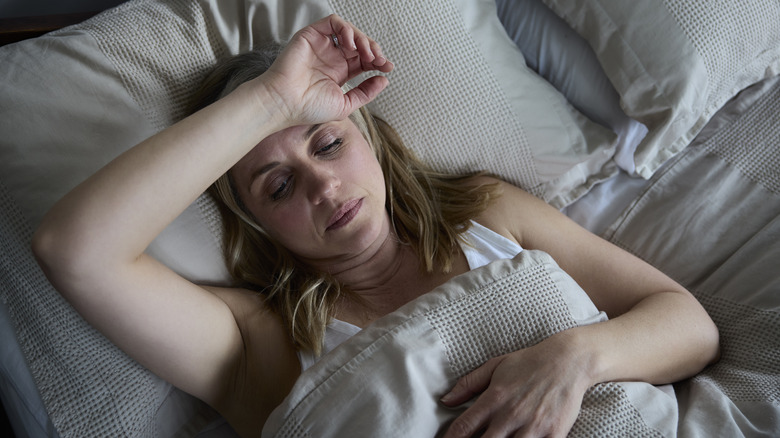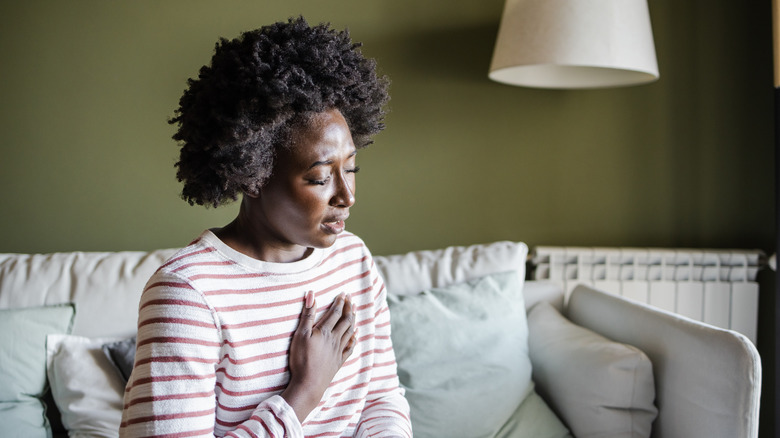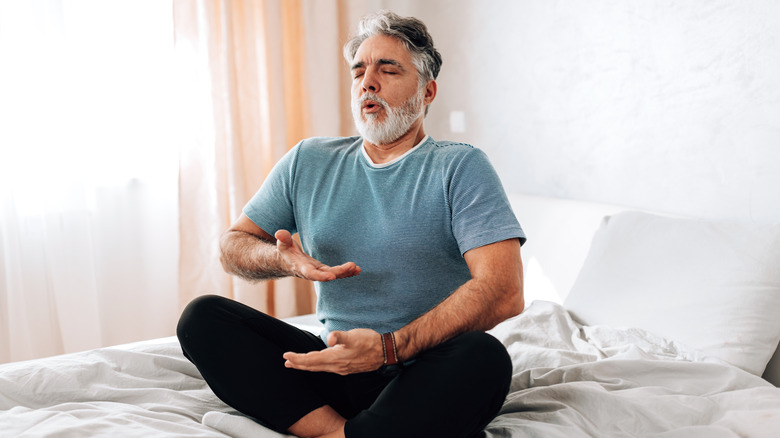What It Means When You Breathe Fast While Sleeping
Even though sleep might seem passive, your body goes to work on restoring your health while you sleep. Your metabolism is much slower, and subsequently, your breathing is slower. Your muscles also relax and begin to repair and restore from your previous day's workout. If you have a sleep tracker, you might also notice your heart rate is much slower than while you're awake. Your blood pressure also settles as your body enters the various stages of sleep (per Somnox).
The number of breaths you take each minute is called your respiratory rate. Your respiratory rate will slow down while you're sleeping or remaining still, but this rate should be consistent each night. What can signal a health condition is noticing a change in your respiratory rate. For example, if your average respiratory rate while you're asleep is 15 breaths a minute, an increase to 19 breaths per minute is dramatic enough to indicate a health condition.
Although these increases in your sleeping respiratory rate still fall within the normal range, they can mean that your body is fighting something such as a cold, injury, inflammation, or reaction to a medication (via Somnofy). A faster-than-normal respiratory rate could also indicate a more serious condition.
When your respiratory rate is above normal during sleep
Everyone's respiratory rate during sleep is different. Your age can determine a normal respiratory rate. According to the Sleep Foundation, adults can range between 12 and 20 breaths per minute, and older adults might breathe up to 28 breaths per minute. That's about a one-second inhale and one-second exhale. Breathing faster than this normal rate is called tachypnea.
Some wearable devices such as the Apple Watch can track your sleeping respiratory rate. You might notice that your respiratory rate will vary throughout the night. During REM sleep, your respiratory rate will be much faster, but deeper sleep stages will slow your respiratory rate. If you have a wearable health tracker, it's a good idea to get a baseline of your sleeping respiratory rate. You can then notice trends in your respiratory rate when you get sick (via Somnofy).
Breathing faster (or slower) than normal could be a sign of a health condition. Tachypnea could indicate anxiety attacks, asthma, chronic obstructive pulmonary disease (COPD), lung infections, blood clots, or heart failure. However, it's not necessarily an indicator of a sleeping disorder. You should see a doctor if your high respiratory rate accompanies difficulty breathing, fever, pulling in your chest, or bluish or grayish skin (via Sleep Foundation).
Treating a fast respiratory rate
Tachypnea is sometimes treated with a mask or a tube inserted in your nostrils in order to deliver oxygen, according to the Cleveland Clinic. For adults, learning how to breathe by engaging your diaphragm can deepen and slow your breath. If respiratory distress is severe, treatment might involve the use of a continuous positive airway pressure (CPAP) machine to provide oxygen under pressure. A ventilator might also be used to help move air in and out of the lungs.
Other treatments, such as an inhaler or antihistamines, will depend on the cause of a rapid respiratory rate. Cognitive behavioral therapy can ease the anxiety that could be tied to tachypnea. You can prevent or reduce some forms of tachypnea through exercise, avoiding smoke, and using a carbon monoxide detector in your home.
If you find yourself breathing fast before you get to sleep, try some relaxation exercises such as breathwork. One popular breathing technique that's been popularized by Andrew Weil is the 4-7-8 breathing technique. You inhale for a count of four, hold for a seven-count, then exhale through pursed lips to a count of eight. By extending the exhale to twice the inhale, you're kicking in your parasympathetic nervous system, which signals your body to relax and restore. Practicing this breathing can ease anxiety, lower blood pressure, and help you sleep (via WebMD).



